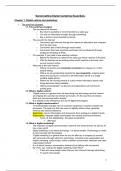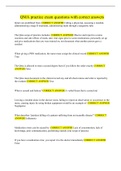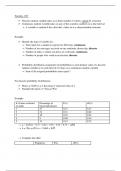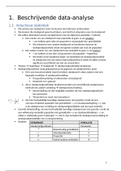Continuous Distributions
Lecture 7.1
Chapter [Paragraph]:
6 [See ‘Lecture 6.2’]
7 [1-2-3-4-5-6]
7.1 Continuous Probability Distributions
PDFs and CDFs
(https://www.statistics.com/glossary/continuous-vs-discrete-distributions/)
(https://www.probabilitycourse.com/chapter4/4_0_0_intro.php)
Discrete distribution
One in which the data can only take on certain values, (for example integers).
Probabilities can be assigned to the values in the distribution:
(The probability that the web page will have 12 clicks in an hour is 0.15).
Continuous distribution
One in which data can take on any value within a specified range (which may be infinite).
Has an infinite number of possible values, and the probability associated with any particular value of
a continuous distribution is null. Therefore, continuous distributions are normally described in terms
of probability density, which can be converted into the probability that a value will fall within a
certain range or interval.
We need to develop new tools to deal with continuous random variables.
The theory of continuous random variables is completely analogous to the theory of discrete random
variables. Indeed, if we want to oversimplify things, we might say the following:
1. Take any formula about discrete random variables,
2. Replace sums with integrals,
Discrete Probability Distribution Function Continuous Probability Density Function
Discrete Cumulative Distribution Function Continuous Cumulative Distribution Function
, 7.2 Uniform Continuous Distribution
(https://www.investopedia.com/terms/u/uniform-distribution.asp)
Uniform distributions are probability distributions with equally likely outcomes.
There are two types of uniform distributions:
Discrete uniform distribution
Each outcome is discrete.
The possible results of rolling a die provide an example of a discrete uniform distribution:
it is possible to roll a 1, 2, 3, 4, 5 or 6, but it is not possible to roll a 2.3, 4.7 or 5.5.
Continuous uniform distribution
Outcomes are continuous and infinite.
An idealized random number generator would be considered a continuous uniform distribution.
With this type of distribution, every point in the continuous range between 0.0 and 1.0 has an equal
opportunity of appearing, yet there are an infinite number of points between 0.0 and 1.0.
Under a uniform distribution, each value in the set of possible values has the exact same possibility of
happening. This distribution, when displayed as a bar or line graph, has the same height for each potential
outcome.
In this way, it can look like a rectangle and therefore is sometimes described as the rectangle
distribution.
, 7.3 Normal Distribution
(https://www.simplypsychology.org/normal-distribution.html)
The normal distribution, or Gaussian distribution, is a continuous probability distribution that is symmetrical
on both sides of the mean, so the right side of the center is a mirror image of the left side. The area under the
normal distribution curve represents probability and the total area under the curve sums to one.
Most of the continuous data values in a normal distribution tend to cluster around the mean (µ), and the
further a value is from the mean (measured in σ), the less likely it is to occur. A normal distribution is
denoted N(µ, σ). For a perfectly normal distribution the mean, median and mode will be the same value,
visually represented by the peak of the curve.
The normal probability density function f(x) reaches a maximum at the median and has points of inflection
at µ ± σ as shown in the chart beneath. Despite its appearance, f(x) does not reach the X-axis beyond µ ± 3σ
but is merely asymptotic to it. Its single peak and symmetry cause some observers to call it ‘mound-shaped’
or bell-shaped’. Its CDF has a ‘lazy-S’ shape. It approaches but never reaches, 1.
Why is the normal distribution important?
The bell-shaped curve is a common feature of nature and psychology.
The normal distribution is the most important probability distribution in statistics because many
continuous data in nature and psychology displays this bell-shaped curve when compiled and
graphed.
For example, if we randomly sampled 100 individuals, we would expect to see a
normal distribution frequency curve for many continuous variables, such as IQ,
height, weight and blood pressure.
Converting the raw scores of a normal distribution to z-scores (see chapter 7.4).
We can standardize the values (raw scores) of a normal distribution by converting them into z-scores.
This procedure allows researchers to determine the proportion of the values that fall within a
specified number of standard deviations from the mean (i.e., calculate the empirical rule).
Lecture 7.1
Chapter [Paragraph]:
6 [See ‘Lecture 6.2’]
7 [1-2-3-4-5-6]
7.1 Continuous Probability Distributions
PDFs and CDFs
(https://www.statistics.com/glossary/continuous-vs-discrete-distributions/)
(https://www.probabilitycourse.com/chapter4/4_0_0_intro.php)
Discrete distribution
One in which the data can only take on certain values, (for example integers).
Probabilities can be assigned to the values in the distribution:
(The probability that the web page will have 12 clicks in an hour is 0.15).
Continuous distribution
One in which data can take on any value within a specified range (which may be infinite).
Has an infinite number of possible values, and the probability associated with any particular value of
a continuous distribution is null. Therefore, continuous distributions are normally described in terms
of probability density, which can be converted into the probability that a value will fall within a
certain range or interval.
We need to develop new tools to deal with continuous random variables.
The theory of continuous random variables is completely analogous to the theory of discrete random
variables. Indeed, if we want to oversimplify things, we might say the following:
1. Take any formula about discrete random variables,
2. Replace sums with integrals,
Discrete Probability Distribution Function Continuous Probability Density Function
Discrete Cumulative Distribution Function Continuous Cumulative Distribution Function
, 7.2 Uniform Continuous Distribution
(https://www.investopedia.com/terms/u/uniform-distribution.asp)
Uniform distributions are probability distributions with equally likely outcomes.
There are two types of uniform distributions:
Discrete uniform distribution
Each outcome is discrete.
The possible results of rolling a die provide an example of a discrete uniform distribution:
it is possible to roll a 1, 2, 3, 4, 5 or 6, but it is not possible to roll a 2.3, 4.7 or 5.5.
Continuous uniform distribution
Outcomes are continuous and infinite.
An idealized random number generator would be considered a continuous uniform distribution.
With this type of distribution, every point in the continuous range between 0.0 and 1.0 has an equal
opportunity of appearing, yet there are an infinite number of points between 0.0 and 1.0.
Under a uniform distribution, each value in the set of possible values has the exact same possibility of
happening. This distribution, when displayed as a bar or line graph, has the same height for each potential
outcome.
In this way, it can look like a rectangle and therefore is sometimes described as the rectangle
distribution.
, 7.3 Normal Distribution
(https://www.simplypsychology.org/normal-distribution.html)
The normal distribution, or Gaussian distribution, is a continuous probability distribution that is symmetrical
on both sides of the mean, so the right side of the center is a mirror image of the left side. The area under the
normal distribution curve represents probability and the total area under the curve sums to one.
Most of the continuous data values in a normal distribution tend to cluster around the mean (µ), and the
further a value is from the mean (measured in σ), the less likely it is to occur. A normal distribution is
denoted N(µ, σ). For a perfectly normal distribution the mean, median and mode will be the same value,
visually represented by the peak of the curve.
The normal probability density function f(x) reaches a maximum at the median and has points of inflection
at µ ± σ as shown in the chart beneath. Despite its appearance, f(x) does not reach the X-axis beyond µ ± 3σ
but is merely asymptotic to it. Its single peak and symmetry cause some observers to call it ‘mound-shaped’
or bell-shaped’. Its CDF has a ‘lazy-S’ shape. It approaches but never reaches, 1.
Why is the normal distribution important?
The bell-shaped curve is a common feature of nature and psychology.
The normal distribution is the most important probability distribution in statistics because many
continuous data in nature and psychology displays this bell-shaped curve when compiled and
graphed.
For example, if we randomly sampled 100 individuals, we would expect to see a
normal distribution frequency curve for many continuous variables, such as IQ,
height, weight and blood pressure.
Converting the raw scores of a normal distribution to z-scores (see chapter 7.4).
We can standardize the values (raw scores) of a normal distribution by converting them into z-scores.
This procedure allows researchers to determine the proportion of the values that fall within a
specified number of standard deviations from the mean (i.e., calculate the empirical rule).











